Afrodita ransomware – a new malware string that targets businesses in Croatia
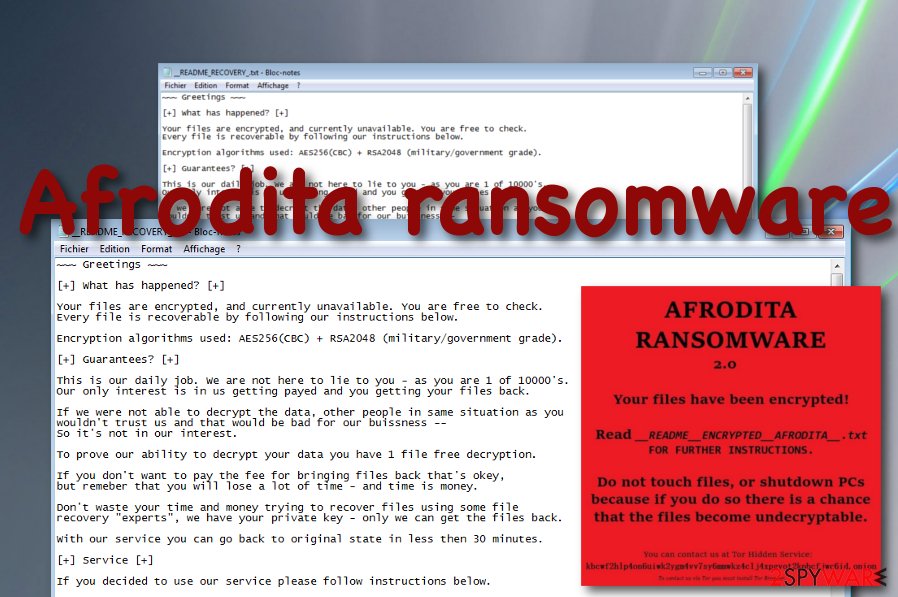
Afrodita ransomware is a dangerous malware form that spreads through email spam and malicious excel documents
Afrodita ransomware is a notorious parasite that is spread via phishing emails and attached excel sheets.[1] The malware uses AES-256 and RSA-2048 keys to lock up files but adds no extension to the filenames. Continuously, the _README_RECOVERY.txt and __README__ENCRYPTED__AFRODITA__.txt. ransom notes are delivered to the computer screen. One of them provides the [email protected] and [email protected] email addresses for making contact with the Afrodita ransomware developers and discussing all the terms about the decryption price when the other one provides a contact link to the Tor web browser.[2] These people offer to send them one file for free decryption to receive evidence that the software truly exists.
Afrodita ransomware plays tricks on random users by getting delivered as the Invoice.xlsm file attached to a phishing email message. It might not seem strange at first but once opened, the attachment places the verynice.jpg file on the computer which is saved as Afrodita.dll. This particular component is the one that executes the malicious infection. Continuously, another file named info.jpg is dropped to the machine and is supposed to change the desktop’s background after the encryption process succeeds.
| Name | Afrodita ransomware |
|---|---|
| Type | Ransomware virus/malware |
| Encryption | The ransomware virus uses the AES-256 and RSA-2048 algorithms to lock up files that are placed on the infected Windows computer system. However, this malware adds no extension after the encryption process |
| Ransom note | The malware displays the _README_RECOVERY.txt and _README_ENCRYPTED_AFRODITA_.txt ransom messages when the encryption on files succeeds |
| Contacts | The criminals provide [email protected] and [email protected] email addresses as a way to contact them and discuss the payment terms and conditions |
| Related files | Afrodita virus is capable of delivering these random files to the computer system: verynice.jpg that is saved as Afrodita.dll and info.jpg |
| Other activities | The ransomware might have other capabilities such as booting up within every startup process, evading antimalware detection, deleting the Shadow Volume Copies of encrypted data, damaging the Windows hosts file, including other malware into the system |
| Spreading | It is known that this malicious string is most commonly delivered through email spam campaigns and malicious attachments such as Invoice.xlsm. However, the malware can also be spread through cracked products that come from p2p networks, malvertising, infectious hyperlinks, fake software updates, and unsecured RDP configuration |
| Removal process | You should get rid of the ransomware virus as soon as you spot it on your Windows computer system. For this process, employ reliable security software only as manual steps might not be enough to terminate the malware fully and safely |
| Fixing tool | If you have discovered any signs that your system might have got compromised during the ransomware attack, try repairing your machine with a piece of software such as Reimage Reimage Cleaner |
Afrodita virus is a notorious infection that can hit any type of user nevermind if the person has high computing skills or weak ones. In order not to get caught by the cybercriminals, you have to manage your received email wisely. If you do not do that, all of your files and documents that are on your infected Windows computer will get encrypted.
It might be hard to spot Afrodita ransomware at first as it does not append any extension to the locked files. However, you can recognize the malware if it changes your background image or displays you this ransom note:
~~~Greetings~~~
[+] What has happened? [+]
Your files are encrypted, and currently unavailable. You are free to check. Every file is recoverable by following our instructions below.
Encryption algorithms used: AES256(CBC) + RSA2048 (military/government grade).
[+] Guarantees? [+]
This is our daily job. We are not here to lie to you – as you are 1 of 10000’s. Our only interest is in us getting payed and you getting your files back.
If we were not able to decrypt the data, other people in same situation as you wouldn’t trust us and that would be bad for our buissness — So it’s not in our interest.
To prove our ability to decrypt your data you have 1 file free decryption.
If you don’t want to pay the fee for bringing files back that’s okey, but remeber that you will lose a lot of time – and time is money.
Don’t waste your time and money trying to recover files using some file recovery “experts”, we have your private key – only we can get the files back.
With our service you can go back to original state in less then 30 minutes.
[+] Service [+]
If you decided to use our service please follow instructions below.
Contact us:
Install Telegram(available for Windows,Android,ios) and contact us on chat: Telegram contact: https://t.me/RecoverySupport
Also available at email [email protected] cc: [email protected]
Make sure you are talking with us and not impostor by requiring by requiring free 1 file decryption to make sure we CAN decrypt!!
Afrodita ransomware offers to deliver the crooks one file for free encryption to receive proof of the decryption software’s existence. These people state that they are the only ones that can recover the blocked data within 30 minutes after the ransom payment. Even though the cybercriminals claim that they are not lying, you can never now.
Victims who fall for believing in the promises of cyber crooks often get scammed and are left without their promised product. The same can happen with Afrodita ransomware developers as these people are orientated only in collecting income. thus, you should avoid making contact with the developers and paying the demanded amount.
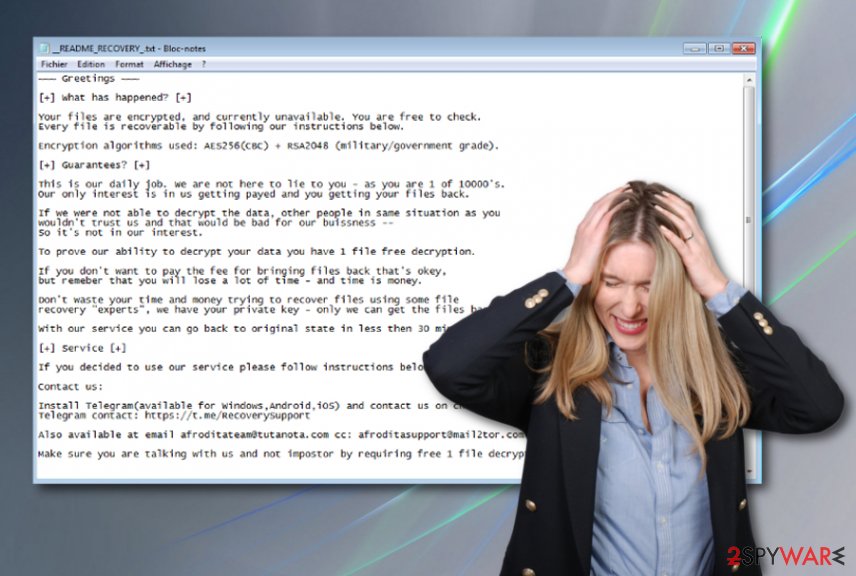
Afrodita malware is ransomware that might be able to delete the Shadow Volume Copies of encrypted files and damage the Windows hosts file
Afrodita ransomware does not provide any particular payment demands but the malware creators can ask for any type of price from tens of dollars to thousands of them. However, the criminals will likely urge some type of cryptocurrency payment, e.g. Bitcoin, to ensure that the transfer process is kept safe and untrackable by federal agencies.
Afrodita ransomware might have a much complex module than it can be thought from the first view. The malware might be able to deactivate antimalware software, boot itself within every startup process, and search for encryptable files and documents in particular time periods, e.g. ten, thirty minutes, one hour, and so on.
Continuously, the malware can be capable of deleting the Shadow Volume Copies[3] of encrypted data in order to hard the decryption process for the users. Another thing that Afrodita ransomware can do is permanently damage the Windows hosts file to prevent access to cybersecurity-related websites, forums, and networks.
Besides all that the ransomware might install other types of malware into the infected computer system, e.g. trojans. For this not to happen, you should remove Afrodita ransomware as soon as you recognize the infection. You should use only reliable automatical software that is capable of eliminating such complex cyber threats.
Even though the ransomware is likely to be eliminated automatically after the files are encrypted, there is no guarantee that this will happen, so you still might have to deal with the Afrodita ransomware removal process. Also, if you find any corrupted areas on your Windows computer system, you can try repairing the damage with software such as Reimage Reimage Cleaner .
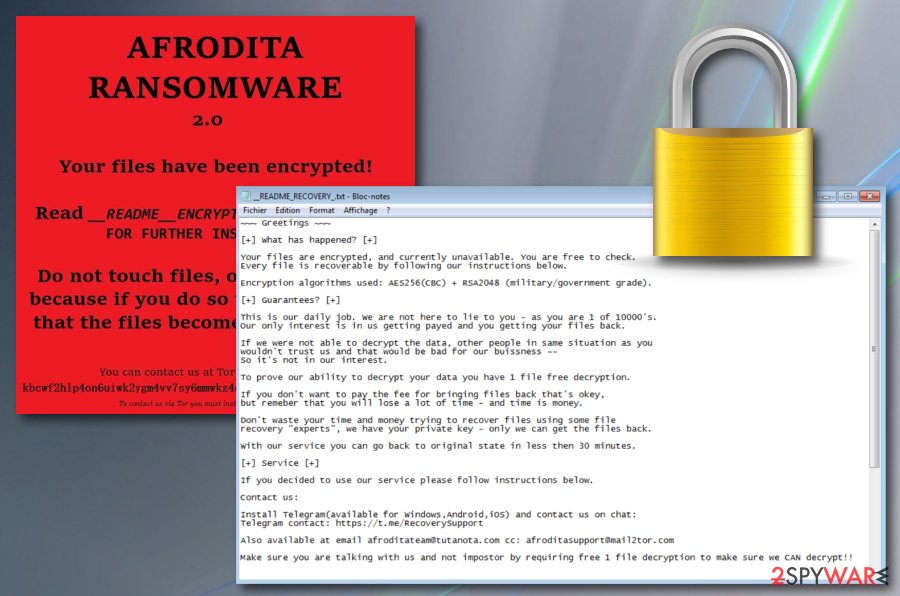
Email spam is the most common ransomware distribution source
Phishing email messages are often dropped to random users by ransomware developers. This is the most popular technique that is employed for pushing the malicious payload. The hackers pretend to be from reliable organizations, companies, and agencies. They attach executables, pdfs, or word documents to the email message where the ransomware infection is hidden. Also, they can include the malware into a hyperlink and insert it into the content of the email.
If you want to protect yourself from ransomware attacks, you should be careful while opening unknown emails. If you were not expecting to receive anything important lately, you should consider deleting the message right away. Also, you should never open questionable-looking attachments without scanning them with antimalware software, try to identify the deliverer of the message and search the email’s content for possible grammar mistakes.
Continuously, ransomware viruses are delivered through unsecured RDP. According to cybersecurity specialists from NoVirus.uk,[4] if the port does not include a strong and reliable password, remote hackers can easily connect to it and brutally enter your computer system. Regarding this fact, never forget to secure your RDP with a strong password. However, there are also more techniques used for ransomware delivery.
These cyberthreats can camouflage as fake software updates, get distributed through malvertising or infectious hyperlinks that are found on third-party networks. Also, peer-to-peer sources are widely distributing various malware strings, including ransomware. The Pirate Bay and other secondary downloading websites are known for their weak protection and ability to carry malware instead of the regular product. Avoid these types of sources, get your programs and products from reliable sources only and use antimalware protection that will alert if something wrong is going on.
The Afrodita ransomware virus elimination guide
Even though Afrodita ransomware should eliminate itself after the encryption process, this might also not happen or the malware might leave additional malicious components on the computer system that also require cleaning.
To remove Afrodita ransomware from your Windows machine, employ reliable and strong antimalware software only, otherwise, the tool might not be capable of proceeding with the elimination. Note that the malware might have filled the Task Manager, Windows Registry and other sections with malicious products that also need to be deleted.
If you are having struggles with Afrodita ransomware removal, you should reboot your machine in Safe Mode with Networking or activate the System Restore feature in order to disable the malicious processes that the ransomware might be running. Afterward, scan your computer system for possible damage with the help of software such as SpyHunter 5Combo Cleaner or Malwarebytes. If these tools find any corrupted areas, you can try repairing them with another program such as Reimage Reimage Cleaner .
When Afrodita ransomware is completely gone and you have returned your computer back to its previous state, you can continue with data recovery. Below we have provided some data restoring methods that might help you.
Remove Afrodita using Safe Mode with Networking
To deactivate the ransomware virus and diminish malicious changes on your Windows computer system, apply the following steps that will help you to boot in Safe Mode with Networking.
- Windows 7 / Vista / XP
- Click Start → Shutdown → Restart → OK.
- When your computer becomes active, start pressing F8 multiple times until you see the Advanced Boot Options window.
- Select Safe Mode with Networking from the list
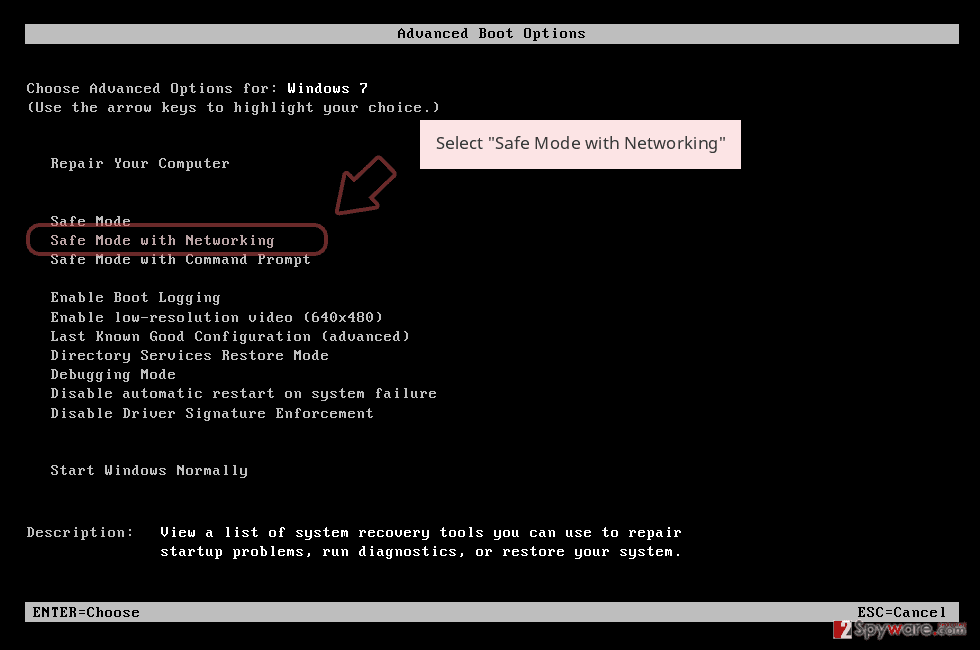
Windows 10 / Windows 8
- Press the Power button at the Windows login screen. Now press and hold Shift, which is on your keyboard, and click Restart..
- Now select Troubleshoot → Advanced options → Startup Settings and finally press Restart.
- Once your computer becomes active, select Enable Safe Mode with Networking in Startup Settings window.
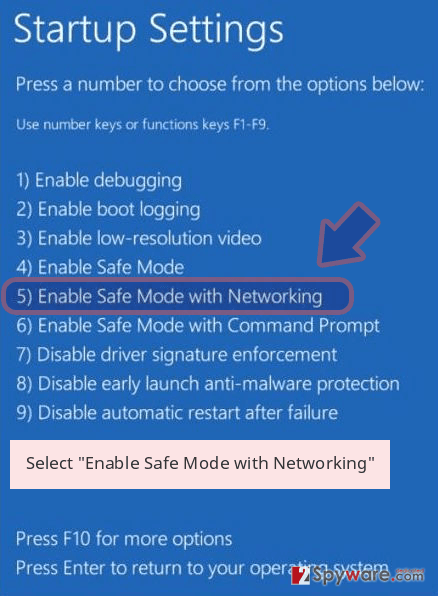
-
Log in to your infected account and start the browser. Download Reimage Reimage Cleaner or other legitimate anti-spyware program. Update it before a full system scan and remove malicious files that belong to your ransomware and complete Afrodita removal.
If your ransomware is blocking Safe Mode with Networking, try further method.
Remove Afrodita using System Restore
To disable the dangerous infection and prevent its malicious processes from continuing, you should activate the System Restore feature on your computer system. Here are instructions on how to do it.
Bonus: Recover your data
Guide which is presented above is supposed to help you remove Afrodita from your computer. To recover your encrypted files, we recommend using a detailed guide prepared by 2-spyware.com security experts.
Afrodita ransomware encrypts files but does not add any extension to the filenames that might make the encryption process hard to spot. However, once you see it, you will not be pleased that you cannot load your files properly anymore. Thus, we decided to try and help people by providing some data recovery software below that might be helpful an allow restoring at least some individual files.
If your files are encrypted by Afrodita, you can use several methods to restore them:
The Data Recovery Pro software can help with file restoring tasks.
If Afrodita ransomware virus has locked your files and documents, you have a chance of restoring them with the help of this software.
- Download Data Recovery Pro;
- Follow the steps of Data Recovery Setup and install the program on your computer;
- Launch it and scan your computer for files encrypted by Afrodita ransomware;
- Restore them.
Windows Previous Versions feature might be capable of recovering some files.
Try using this tool for recovering at least some of your documents that were affected by the ransomware virus. However, this method requires booting the computer in System Restore before completing the recovery with this tool
- Find an encrypted file you need to restore and right-click on it;
- Select “Properties” and go to “Previous versions” tab;
- Here, check each of available copies of the file in “Folder versions”. You should select the version you want to recover and click “Restore”.
Using Shadow Explorer might help you with data recovery.
This tool might allow you to restore at least some of your individual files. However, note that this method might not work if the ransomware virus has deleted the Shadow Copies of encrypted data.
- Download Shadow Explorer (http://shadowexplorer.com/);
- Follow a Shadow Explorer Setup Wizard and install this application on your computer;
- Launch the program and go through the drop down menu on the top left corner to select the disk of your encrypted data. Check what folders are there;
- Right-click on the folder you want to restore and select “Export”. You can also select where you want it to be stored.
Currently, the cybersecurity specialists are working on the decryption key’s development.
Finally, you should always think about the protection of crypto-ransomwares. In order to protect your computer from Afrodita and other ransomwares, use a reputable anti-spyware, such as Reimage Reimage Cleaner , SpyHunter 5Combo Cleaner or Malwarebytes
This entry was posted on 2020-01-10 at 08:05 and is filed under Ransomware, Viruses.

